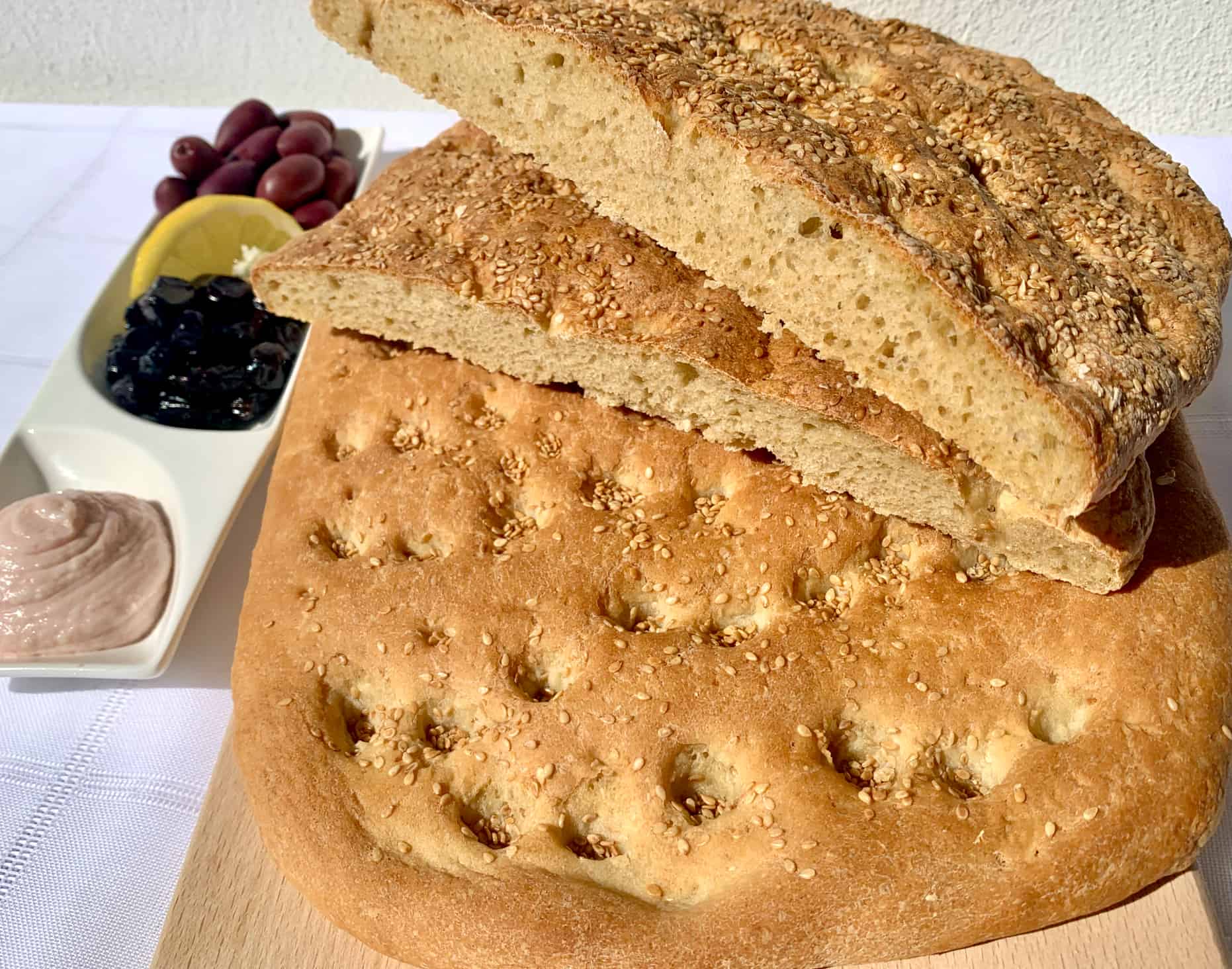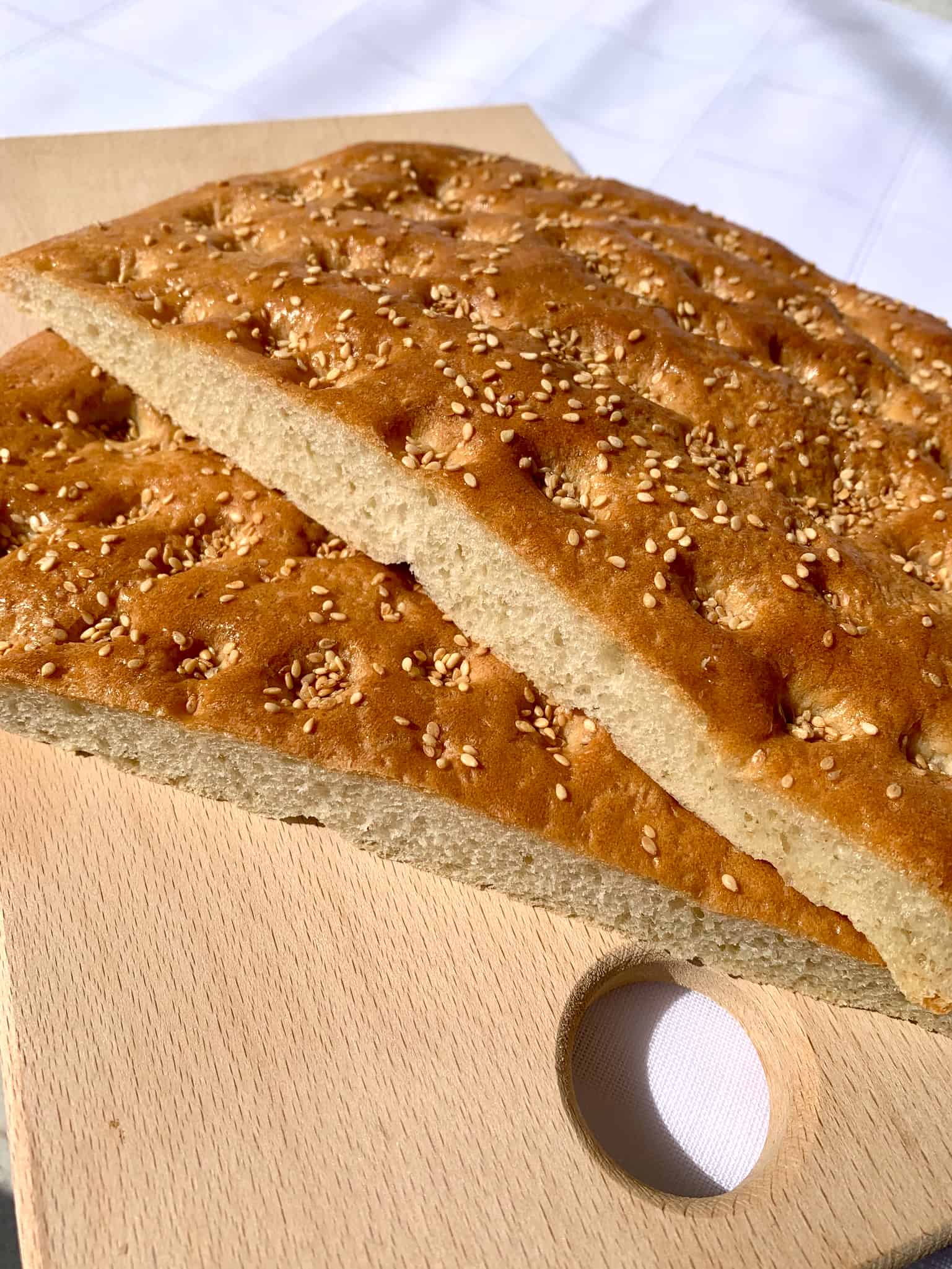Greek Lagana Bread Recipe is a traditional type of Greek Flatbread baked and consumed on Clean or Pure Monday alone. Clean or Pure Monday is a national holiday in Greece where people gather outdoors and celebrate with the kite flying. Lagana Flatbread is a special type of Greek bread which is crunchy on the outside whilst fluffy on the inside covered with sesame seeds. It resembles closely the Italian Flatbread and has a very long history attached to it.

What is Lagana bread?
Lagana bread or Clean Monday Bread is a special type of Greek Lenten bread prepared and eaten on Clean or Pure Monday. It is simple to make and requires a few cupboard ingredients alone. The traditional Greek Lagana bread has a distinctive appearance with multiple little dimples on the surface and covered with sesame seeds. It is crunchy on the outside, fluffy on the inside and it is very similar to the Italian flatbreads.
What is the history behind Lagana Bread?
Lagana bread history dates back to before the Old Testament where Isreali people were offered bread from God on their way to the Promise Land. In Greece, Greek Lagana Bread epitomises the easter lent as it is intentionally simple with only a few ingredients in its core. Therefore, it marks the beginning of simplicity and the sacrifices that lay ahead.
Lagana is consumed on Clean or Pure Monday which is a national Bank Holiday. It is a moveable date and is the seventh Monday before Easter. Clean Monday commemorates the beginning of Sarakosti or the Great Lent for Easteror Pascha. Clean Monday prepares people to ‘clean’ their spiritual selves and prepare for Easter but also, surprisingly, its the day where the olden day housewives would spend their entire day cleaning the kitchen utensils!
Sarakosti literally means the 40 days of Lent prior to Easter. During lent it is customary not to eat meat, eggs and dairy products but you can eat fish, calamari, squid and many more lenten dishes, also called Nistisima or Lenten Food.
Other traditional Greek Lenten bread Recipe
One special type of Lagana Bread is that of ‘Kyra Sarakosti’, a bread shaped like a woman carrying a cross on her head, hands crossed as if praying, without a mouth as she is fasting and with seven legs. Each leg represents the seven weeks of Great Lent. Every Saturday on the run up to easter, the woman of the house breaks off one of the seven legs, with the last leg coming off on the Great Saturday just before Easter. She then hides that last leg in either a fig or an Easter bread bun and gives it away. Whoever finds the bread leg is considered as the lucky one for the year ahead, very much like the New Year’s tradition!

How can I make Greek Lagana bread?
My recipe for the traditional Greek Lagana bread is super easy, simple and utilises ingredients you will already have in your cupboard. Start by assembling your ingredients and kitchen utensils. It is a lot easier to make this traditional Lagana Bread with an electric stand mixer , though do not despair if you do not have one. You can still knead the dough by hand instead.
Start the Greek Lagana Bread recipe by assembling and weighing your ingredients. Add 100gr of the flour in a bowl along with lukewarm water and yeast. Mix the ingredients using your hands or your stand mixer till combined. When done, let the dough rest for 15 minutes in a warm place. Once the dough has rested, add the remaining flour and salt and knead for about 10 minutes until the dough is nice and soft. Cover your bowl with a kitchen towel and let it rest for a further 30-40 minutes.
While the dough is bulk proofing, take two baking trays and line them with parchment paper. Sprinkle the parchment paper with sesame seeds and put the baking trays aside.
Once the dough has finished its bulk proofing, knead it for a further 5-7 minutes. Divide the dough into two parts and roll each one on the prepared baking tray, shaping either round or oval. Let the dough prove for a further 30-40 minutes.
Meanwhile, mix either sugar or honey with water in a bowl. Mix until the sugar or honey are combined and set aside.

This recipe will give you two delicious Lagana Flatbreads.
Tip: If you’d like to make your Greek Lagana bread crunchier, put a baking tin in the bottom of your oven filled with a couple of cups of boiling water whilst Lagana is baking. As the temperature rises, the steam will give your bread that delicious crunch you’re looking for!
What can I pair Greek Lagana Bread with?
Greek Lagana Bread is most always eaten with olives and Taramosalata (Fish roe dip) and of course with a bowl of delicious Fasolada (Greek bean soup).
Traditional Lenten Recipes
Another special bread type of bread marking the beginning of the Great Orthodox Fasting period is Kyra Sarakosti or Lent Lady. Try my Kyra Sarakosti recipe and get your little helpers involved! A truly fun activity to mark the holy season with your little ones!



